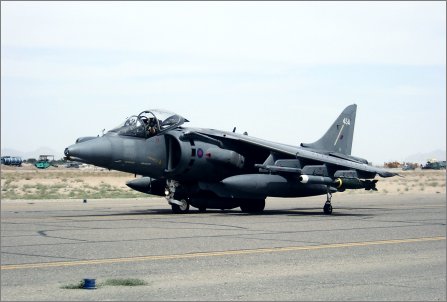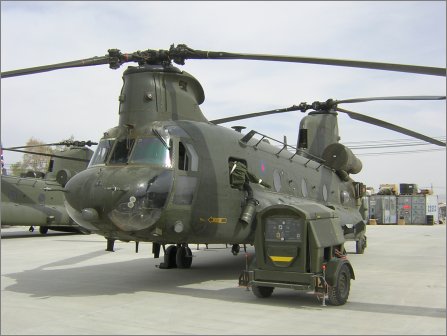CRAIG HOYLE / KABUL & KANDAHAR AIRFIELD
The UK is establishing a 3,300-strong reconstruction force in southern Afghanistan. Flight International visited the country to witness the build up
After registering as little more than a blip on the radar screens of British newspapers for the last three years, Afghanistan is set to secure more column inches this year as the UK expands its military presence in the country to over 3,300 troops. Focused in the southern Helmand province, this build-up is already in full swing, with regular flights leaving the UK carrying personnel and equipment to support Stage 3 of the NATO-led International Security Assistance Force’s (ISAF) activities in the former Taliban-ruled nation.
Flight International visited the Afghan capital Kabul and Kandahar airfield in early April to witness preparations for the UK’s three-year, £1 billion ($1.7 billion) Operation Herrick commitment, which is intended to bring stability to Helmand – the heartland for Afghanistan’s opium cultivation activities.
|
| The UK's C-17s are playing a vital role in the delivery of British helicopters to Kandahar airfield |
 |
| Harrier GR7As can use CRV-7 rockets and unguided bombs |
 |
| Six RAF Chinook HC2s will support UK operations in Helmand province |
Ground work
“The UK footprint is very small, but there are a lot of folks here already in the multinational force,” says Royal Air Force Gp Capt Ian Morrison, deputy commander British Forces (Air). Australia, Canada, Denmark, Estonia, France, Italy, the Netherlands, New Zealand, Romania and the USA also have troops in southern Afghanistan.
The UK is currently operating an air bridge between the UK, Kabul and Kandahar using RAF Lockheed TriStar C2s and Boeing C-17s, in addition to flying Lockheed Martin C-130J/K transports and Boeing CH-47 Chinook HC2 transport helicopters in theatre and maintaining a detachment of six BAE Systems Harrier GR7A ground-attack aircraft. Eight Army Air Corps Westland/Boeing Apache AH1 attack helicopters and four Westland Lynx light utility helicopters will also arrive within the next month (Flight International, 7-13 February).
British forces are now establishing a presence in the capital of Helmand province, Lashkar Gar, and building Camp Bastion as a headquarters for the Third Battalion, The Parachute Regiment. Camp Bastion’s tactical landing strip opened for business on 10 April, when an RAF C-130J became the first fixed-wing transport to deliver supplies.
An initial priority will be to secure a triangle of territory between Lashkar Gar, Camp Bastion and Gereshk along the Helmand River valley – the centre of Afghanistan’s poppy growing industry, before expanding across the province. This is expected to be a dangerous duty, with Taliban fighters well established and equipped with small arms, heavy calibre weapons and rocket-propelled grenades.
“The area is a hostile place; there are IEDs [improvised explosive devices] and bombs out there,” says Morrison. “The Taliban are an organised group and have spent time getting their military tactics together. They are an intelligent enemy.” A recent spate of suicide bombings aimed at coalition and Afghan national army personnel in Herat, Konduz and Lashkar Gar have made the headlines and highlighted the volatile situation which faces the expanding ISAF mission.
In announcing the increased UK commitment to Afghanistan early this year, UK defence secretary John Reid said a key goal of the mission would be to help the Afghan people find “real alternatives to the harvesting of opium”. UK military officials in Afghanistan stress that their activities do not include the eradication of poppy crops, with much of this work conducted by US personnel. On 3 April the coalition destroyed poppy seed resin with a value of $80 million to local farmers.
With the RAF’s four C-17s tasked with deploying heavy equipment, including the service’s Chinooks, the bulk of the UK’s passenger transport needs are being met by three TriStar C2s. Once in theatre, personnel are moved by three stretched- fuselage C-130Js and one C-130K. Two C-130Js are assigned for routine passenger transport between Kabul and Kandahar and to support ISAF commitments (see box P39), with a third aircraft held in reserve. However, an eventual split of two C-130Js and two C-130Ks is likely to be maintained. The UK’s Hercules largely conduct only daylight operations due to flying constraints at Kandahar, and the RAF is exploring the possibility of landing its C-130s on the facility’s taxiways if its main runway becomes unusable while resurfacing work takes place.
Although an expected threat from surface-to-air missiles (SAM) has so far failed to materialise, all RAF transports operate in Afghanistan with defensive aids equipment. “We want to make sure we go that 1% further than everyone else in taking precautions and being less predictable,” says a senior C-130K pilot. The UK’s caution comes from fresh and bitter experience, as one of its C-130Ks was shot down over Iraq early last year, killing 10 personnel. In the only reported incident of its kind involving a British transport aircraft in Afghanistan, an RAF C-17 was targeted by “small surface-to-air fire” last October, but no damage was sustained.
Chinook role
Additional intra-theatre transport services are being provided by 27 Sqn Chinook HC2s currently operated by the RAF’s 1310 Flight. Six of the aircraft are now positioned at Kandahar, with the last having arrived by C-17 in mid-April. Hot-and- high environmental conditions mean the aircraft are operating “pretty much on the limit of their performance,” says Wg Cdr Dan Startup, officer commanding 1310 Flight, and as temperatures climb to over 40°C (104°F) by mid-year, the aircraft will be forced to carry a reduced payload. However, he notes: “Nothing else can fly throughout the year.”
The vast majority of tasks so far allocated to the RAF’s Chinooks have centred on supporting the establishment of Camp Bastion, and in delivering supplies to the UK task force in Lashkar Gar and Gereshk. Loads have primarily comprised food, water, ammunition and some underslung vehicles. The aircraft do not conduct operations outside Helmand province and have so far not supported any special forces activities, says Startup.
“There is a lack of heavylift in the area, so we have worked with the Dutch, French, Canadians and Australians – we are fully embedded within the coalition.” Kandahar airfield also hosts US CH-47s, Boeing AH-64 Apaches, and Sikorsky UH-60 Black Hawks and HH-60 Pave Hawks supporting Operation Enduring Freedom.
Startup describes operations in Afghanistan as “a lot more comfy and with more support” than the Chinook force’s earlier commitment in southern Iraq. “There is lots of intelligence of hostile intent, but our operations are planned to avoid them. We have differed our concept of operations from other forces in country,” he says, primarily referring to the small force size, flight levels and speeds favoured by RAF Chinook crews.
Harrier operations
The UK presence in Afghanistan is not, however, contained to the provision of transport services, with its Joint Force Harrier having operated six Harrier GR7A strike aircraft from Kandahar since September 2004.
RAF and US Air Force aircraft including Fairchild A-10s and Boeing B-52 bombers currently fly around 20 close air support, air interdiction and reconnaissance missions over Afghanistan each day, providing vital support to coalition and Afghan troops, route patrols and reconstruction activities.
Two Harriers operate as a pair while conducting ISAF patrols, with another two maintained at ground alert readiness. The aircraft operate with different weapon and sensor loads to maximise their flexibility during any given mission. The flight leader carries two 245kg (540lb) freefall bombs with airburst and impact fuzes, two rocket pods respectively containing six and 19 unguided CRV-7 rockets and the digital Joint Reconnaissance Pod, which lacks a datalink, but can provide tactical images within 30min of the aircraft landing. The second Harrier carriers a 450kg unguided airburst bomb, one 540kg Enhanced Paveway II laser/GPS-guided weapon and a TIALD targeting pod.
Tanker support
Both carry external fuel tanks to boost mission endurance to over 2h, with tanker support also provided when required by USAF Boeing KC-135s.
Joint Force Harrier’s pilots – which have until now been drawn from the RAF’s 1 and 4 Squadrons – employ a tactic of scaled response to hostile ground activity, ranging from descending from over 20,000ft (6,100m) to make noise at around 10,000ft, to conducting low-level passes before any ordnance is dropped.
“Nine times out of 10, noise on the ground is all we need,” says 1 Sqn pilot Flt Lt Ian Bews. “But if we need a show of force we come in at 100ft.”
Although this exposes the aircraft to a potential risk from small arms fire or even SAMs, Bews notes: “None of our jets have taken bullets.” However, the dangers of the Afghan theatre were highlighted last October, when two GR7As suffered shrapnel damage during a rocket attack on Kandahar.
When the use of weapons is required, pilots talk to forward air controllers on the ground before positively identifying their targets using gyro-stabilised binoculars. Bews says the most commonly used weapon is the CRV-7 – with a 19-rocket pack capable of covering an area of around 200m (650ft) – followed by 245kg bombs. “The majority of the missions are very quiet and not a lot happens,” he says. “But if the [ground] convoy gets there and nothing happens it’s really good.” Under current plans the UK’s Joint Force Harrier detachment is to stand down on 30 June, exactly as UK troop strength is scheduled to peak in the volatile Helmand province.
A decision to extend a Harrier presence at Kandahar will be made following an assessment of the availability of suitable replacements within the coalition, such as the proposed relocation of Royal Netherlands Air Force Lockheed F-16s from Kabul or the possible deployment to Afghanistan of Italian air force AMX ground-attack aircraft. However, the poor condition of the runway at Kandahar is threatening such moves, with its current usable length of 1,520m changing frequently as running repairs are made and resurfacing activities take place. The presence of landmines on the base is further complicating steps to improve infrastructure and means that the Harrier is the only strike aircraft now capable of operating at the site, needing only around 900m of runway to get airborne.
The UK’s Harriers conduct only daytime operations, with the USAF’s Bagram-based A-10s better equipped for night-time duties.
Withdrawal concern
The decision to withdraw the Harrier force has worried many observers, including the House of Commons’ cross-party Defence Select Committee. In its 6 April report The UK deployment to Afghanistan, it said: “The availability of close air support providing sufficient mobility and fire power will be absolutely essential to the success of the Helmand deployment. We recommend, if no equivalent force can be provided by the NATO force generation process, that the Harrier GR7 squadron based at Kandahar should remain beyond June 2006 and for as long as necessary.”
With conditions on the ground likely to rule against a safe withdrawal, Joint Force Harrier’s newly reformed 800 NAS is already making preparations to deploy later this year.
Source: Flight International

















